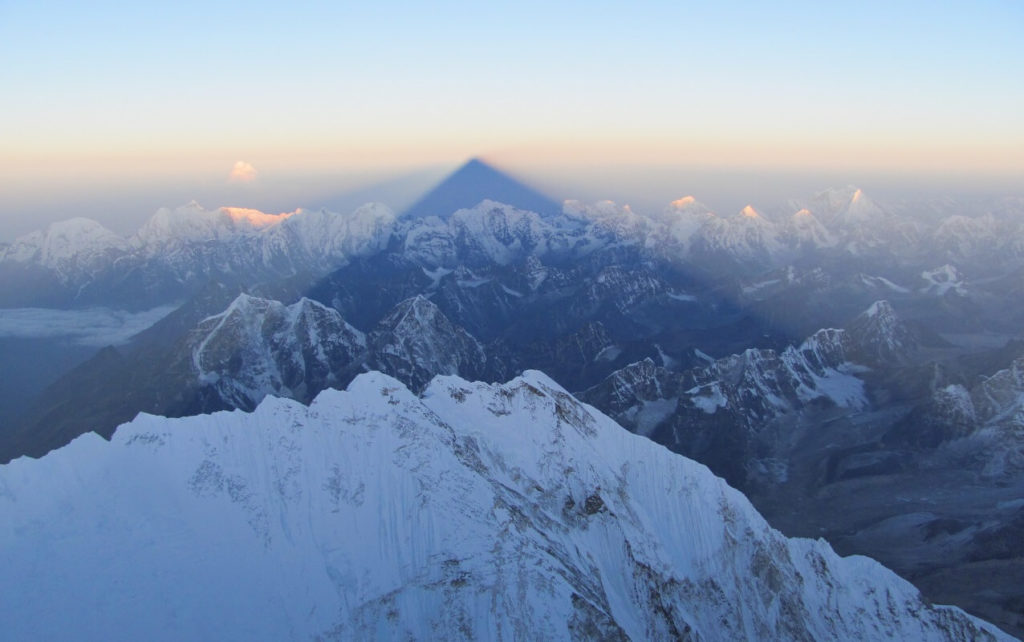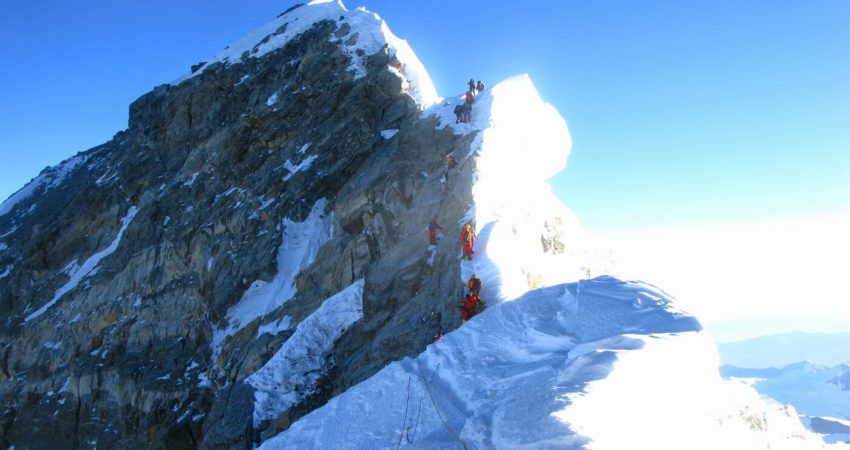Team: High Adventure Expeditions – Mount Everest 2022
Route: South-East Ridge
Dates: April 14 to June 1 2022
Cost: US$41,500 per person
Required Equipment: Everest Gear List
Application Form: Everest Summit with High Adventure Expeditions
High Adventure Expeditions will meet in Kathmandu for our Mount Everest 2022 Expedition.
The bustling, energetic, and exciting city has amazing sights to see and things to do. But most of all, we love to gear-shop! Kathmandu has a good selection of local and international mountaineering equipment and clothing in its stores. We always find something that we can’t do without. After spending a day doing last minute shopping and ensuring our bags are properly packed, we start our journey to Base Camp.
“Base Camp on the south side of Everest is reached over an eight-day leisurely trek through Sherpa villages”
We’ll begin by taking a 40 minute flight to Lukla. In pre-expedition times people had to walk from Kathmandu, since there were no motorable roads or airports beyond the capital. The expedition supplies are carried from Lukla to Base Camp by yaks, zokyos (yak hybrids), and porters.
On the way we’ll stop at Pangboche village , which is one of the oldest villages of the Khumbu valley. Next morning we’ll visit the monastery, which also houses the Yeti’s Skull. We’ll request a special blessing from the highly regarded local lama (monk), Lama Geshi, who normally does puja for all expeditions above this ancient village, to solicit the local deities’ blessing for a peaceful and safe expedition for all members. We accept good wishes in the form of a khata (a scarf with the eight lucky signs displayed by Buddhist during all religious and farewell ceremonies) from the lama and continue our walk up to Base Camp.
At Base Camp, a final ceremony will be celebrated for all expedition members and equipment that we will take with us up onto the mountain. After the puja is performed, the Sherpas will begin their work of transporting the equipment, high altitude food, and other supplies to the higher camps, leaving us to make a training climb on surrounding peaks for acclimatization. After a week acclimatizing, High Adventure Expeditions will begin the climb to Camps I, II, and III. Following the normal procedure, the members will take the route up to Camp II at least twice and up to Camp III at least once.
The climb from Base Camp begins early in the morning to avoid the possible hazard of seracs in the Khumbu Icefall, the most difficult section.
From Camp I, climbers cross a broad flat glacial valley, famously known as the Western Cwm, and reach Camp II (ABC) at the foot of the Lhotse face, a warm place to camp. Camp III is halfway up the Lhotse face, precariously and spectacularly perched and is reached by fixed rope. Camp IV (the South Col) is 500 metres above Camp III and up, over and across the Yellow Band and Geneva Spur. The South Col is the last camp before the summit. The summit push is made from here, with 10 to 12 hours of climbing in the night, aiming to reach the summit at around 7 a.m. Each climber who has made it to Camp IV will have a maximum stay of three days at this altitude, depending on supplemental oxygen supplies and physical and weather conditions, to prepare for and complete the summit push.
Insurance – Please note that the vast majority of expenses of running an Everest expedition are paid for upfront, this means that in the event of cancellation, as happened in 2014 and 2015, there will be no refunds. We recommend each climber purchase their own travel insurance to cover this eventuality.
Mount Everest Climbing Schedule:

Services Included:
- Cargo clearance
- All related airport / hotel / airport transfers
- Hotel accommodation in Kathmandu on B&B basis (4 star)
- Kathmandu / Lukla / Kathmandu airfare both for member and staff
- Full board service Kathmandu to Kathmandu
- All necessary expedition material transport (Lukla / BC / Lukla) by yaks or porters and all their expenses
- BC & ABC Nepali Cooks with equipment, wages, insurance
- Dining and kitchen tent in ABC with high altitude cook
- 1 to 1 member to climbing Sherpa ratio with equipment, wages, insurance
- All mountain tents provided. Single Tent at BC and 2 people to a three-men tent above BC
- Gas heaters in the dining tent & solar panel power available at BC
- Dining Tables and chairs
- Climbing Permit and all necessary permits
- Garbage deposit
- Ice fall route maintenance fee
- Radio walkie-talkie set for climbers and Sherpas, including permit charges
- EPI Gas with burner and cooking pot set
- High altitude food with personal pack
- 5 cylinders of oxygen (brand new Poisk) per climber with mask and regulator set
- 3 cylinders of oxygen (refilled) per climbing Sherpa with mask and regulator set
- Liaison Officer charges including airfare and insurance
- Shower tent at BC
- Toilet tent at BC & CII
- Toilet tent at BC & CII
- Gamow Bag at CII
- Satellite telephone (per minute rates apply)
Trekking Porter: To make the trek to Base Camp a little more comfortable, a personal porter will carry the majority of a climber’s trekking clothes and equipment. Although this is definitely a luxury, it’s one that can pay real dividends later on higher up in the mountain.
Expenses Not Included:
- Travel insurance (should include helicopter evacuation)
- International air tickets
- Nepal entry visas ($100)
- Lunch & dinner in Kathmandu
- Lunch & dinner in Kathmandu
- Personal climbing equipment
- Expenses of a personal nature
- Tips (you should allow up to $1000 in tips for Everest summiteers)
Other Costs:
Personal Sherpa: Most expeditions ensure that on summit day everyone is teamed up with a Sherpa for a 1:1 ratio of climber:sherpa, but lower on the mountain climbers are on their own. At High Adventure Expeditions we believe in the value of climbing alongside a Sherpa. Lower on the mountain, High Adventure Expeditions feel there is a great advantage to having a Sherpa to help on an everyday basis. As a result we include, in the price, a climbing Sherpa to accompany climbers from Base Camp up. If you want your own personal Sherpa who works only with you, this will be an added expense of $5,000.
Additional Oxygen: Each team member will have 5 bottles of oxygen for their summit push. This should be more than enough and has a safety margin built in. However some climbers like to have additional bottles available to them. These must be ordered at the time of booking because of the long lead time needed to get them from the factory. They cost $600 each.
